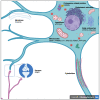Animal Models of Autosomal Recessive Parkinsonism
- PMID: 34356877
- PMCID: PMC8301401
- DOI: 10.3390/biomedicines9070812
Animal Models of Autosomal Recessive Parkinsonism
Abstract
Parkinson's disease (PD) is the most common neurodegenerative movement disorder. The neuropathological hallmark of the disease is the loss of dopamine neurons of the substantia nigra pars compacta. The clinical manifestations of PD are bradykinesia, rigidity, resting tremors and postural instability. PD patients often display non-motor symptoms such as depression, anxiety, weakness, sleep disturbances and cognitive disorders. Although, in 90% of cases, PD has a sporadic onset of unknown etiology, highly penetrant rare genetic mutations in many genes have been linked with typical familial PD. Understanding the mechanisms behind the DA neuron death in these Mendelian forms may help to illuminate the pathogenesis of DA neuron degeneration in the more common forms of PD. A key step in the identification of the molecular pathways underlying DA neuron death, and in the development of therapeutic strategies, is the creation and characterization of animal models that faithfully recapitulate the human disease. In this review, we outline the current status of PD modeling using mouse, rat and non-mammalian models, focusing on animal models for autosomal recessive PD.
Keywords: Parkinson’s disease; animal model; autosomal recessive Parkinsonism; dopaminergic neurons.
Conflict of interest statement
The authors declare no conflict of interest.
Figures
References
-
- Obeso J.A., Stamelou M., Goetz C.G., Poewe W., Lang A.E., Weintraub D., Burn D., Halliday G.M., Bezard E., Przedborski S., et al. Past, present, and future of Parkinson’s disease: A special essay on the 200th Anniversary of the Shaking Palsy. Mov. Disord. 2017;32:1264–1310. doi: 10.1002/mds.27115. - DOI - PMC - PubMed
Publication types
Grants and funding
LinkOut - more resources
Full Text Sources
Miscellaneous



